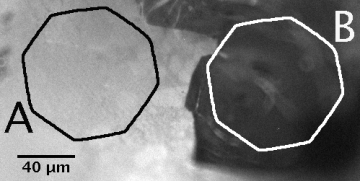Modification of gold surfaces with a SAM of DNA forms the basis of a number of proposed electrochemical biosensors.
Study of the nature of the DNA SAM coated electrode surface
The quality of the DNA SAM prepared by various methods is under study. Our initial report on the variation in the surface coverage across the gold electrode surfaces was a collaboration with Prof Hogan YU (SFU). We compared two methods of preparing the DNA SAMs and characterized the extent of heterogeneity.
- Murphy, J. N., Cheng, A. K. H., Yu, H. Z. & Bizzotto, D. On the nature of DNA self-assembled monolayers on Au: measuring surface heterogeneity with electrochemical in situ fluorescence microscopy. J. Am. Chem. Soc 131, 4042–4050 (2009). doi:10.1021/ja808696p (You can view the full text of this article here)
Using DNA nanocubes for modifying gold electrodes
The formation of high quality DNA modified electrode surfaces were realized using DNA nanocubes. The formation, characteriztion and use of DNA nanocube modified gold surface for sensing nucleic acids, or protein was demonstrated through FRET measurements while controlling the electrode potential.

- Grzedowski, A. J.; Jun, D.; Mahey, A.; Zhou, G. C.; Fernandez, R.; Bizzotto, D. Engineering DNA Nanocube SAM Scaffolds for FRET-Based Biosensing: Interfacial Characterization and Sensor Demonstration. J. Am. Chem. Soc. 2024, 146 (46), 31560–31573. https://doi.org/10.1021/jacs.4c09240.
Using potential to control the formation of DNA SAMs
The formation of a well organized low coverage DNA SAM can be accomplished using potential assisted thiol exchange.

- Leung, K. K.; Martens, I.; Yu, H. Z.; Bizzotto, D. Measuring and Controlling the Local Environment of Surface-Bound DNA in Self-Assembled Monolayers on Gold When Prepared Using Potential-Assisted Deposition. Langmuir2020, 36 (24), 6837–6847. https://doi.org/10.1021/acs.langmuir.9b03970.
- Leung, K. K.; Yu, H.-Z.; Bizzotto, D. Electrodepositing DNA Self-Assembled Monolayers on Au: Detailing the Influence of Electrical Potential Perturbation and Surface Crystallography. ACS Sensors 2019, 4 (2), 513–520. https://doi.org/10.1021/acssensors.8b01695.
- Leung, K. K.; Gaxiola, A. D.; Yu, H.-Z.; Bizzotto, D. Tailoring the DNA SAM Surface Density on Different Surface Crystallographic Features Using Potential Assisted Thiol Exchange. Electrochim Acta 2018, 261, 188–197. https://doi.org/10.1016/j.electacta.2017.12.114.
Measuring the thermal stability of DNA SAMs
Often, DNA SAMs are exposed to high temperature buffers to encourage hybridization. An assessment of the thermal stability can be done using fluorescence and electrochemistry. It appears that the stability is very dependent on the atomic arrangement of the underlying gold surface.


- Ma, T.; Bizzotto, D. Improved Thermal Stability and Homogeneity of Low Probe Density DNA SAMs Using Potential-Assisted Thiol-Exchange Assembly Methods. Anal Chem 2021, 93 (48), 15973–15981. https://doi.org/10.1021/acs.analchem.1c03353.
- Ma, T.; Martens, I.; Bizzotto, D. Thermal Stability of Thiolated DNA SAMs in Buffer: Revealing the Influence of Surface Crystallography and DNA Coverage via In Situ Combinatorial Surface Analysis. Langmuir 2020, 36 (48), 14495–14506. https://doi.org/10.1021/acs.langmuir.0c01828.
Measuring the dynamics of potential driven DNA reorientation in a mixed SAM layer on the gold electrode surface
The change in DNA SAM orientation as driven by the charge on the electrode surface and measured using the in-situ fluorescence microscopy method has been reported. We showed that using microscopic methods, in-situ, we can characterize different parts of the electrode surface, and that the signals can be different on either side of a grain boundary.
-
(1) Casanova-Moreno, J.; Bizzotto, D. A Method for Determining the Actual Rate of Orientation Switching of DNA Self-Assembled Monolayers Using Optical and Electrochemical Frequency Response Analysis. Anal Chem 2015, 87 (4), 2255–2263. https://doi.org/10.1021/ac503919a.

Fluorescence image of DNA SAM. The fluorescence intensity is dramatically different on either side of the grain boundary
